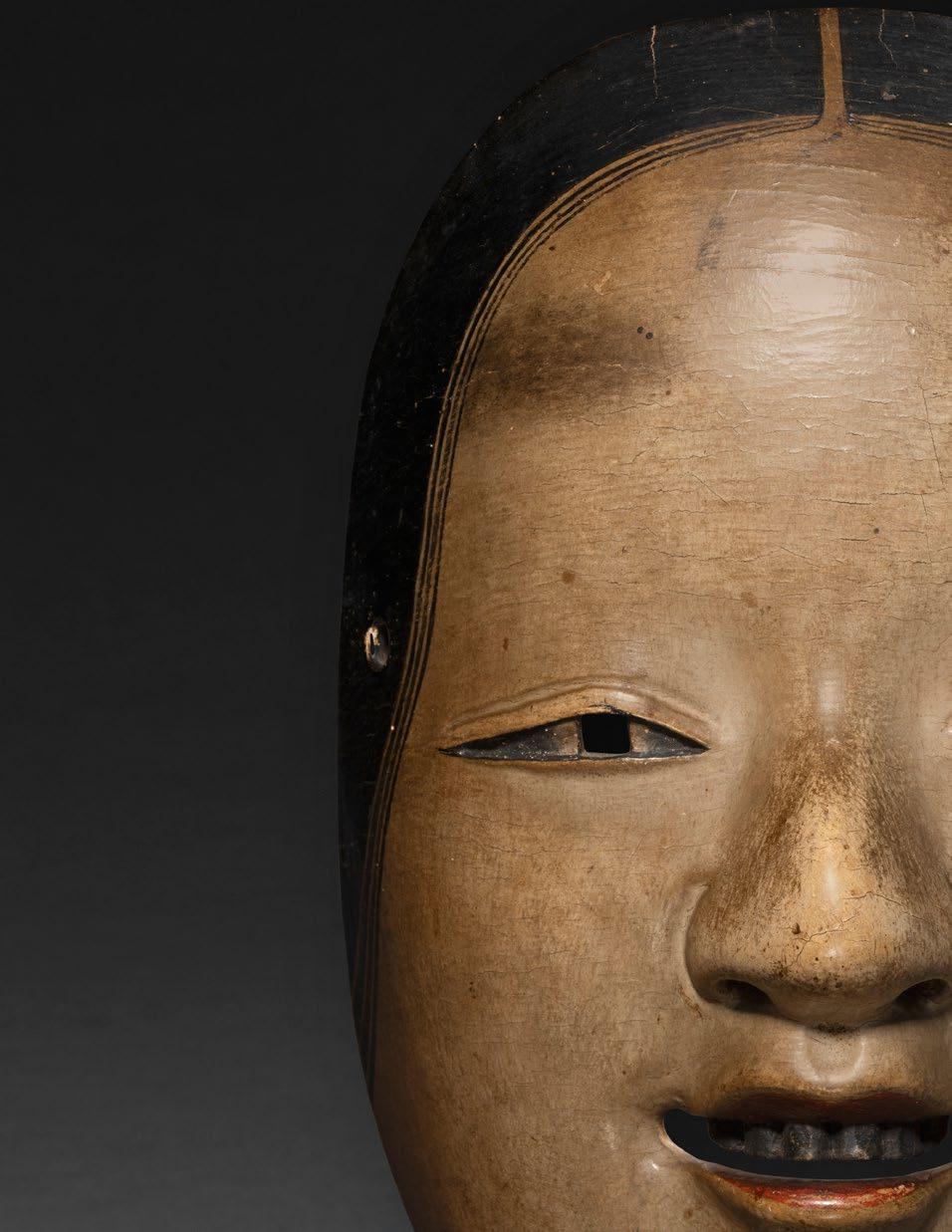J une a R t WORKS
Pieces are published and changed each month. The objects are presented with a full description and corresponding dealers contact information Unlike auction sites or other platforms, we empower collectors to interact directly with the member dealers for enquiries and purchases by clicking on the e-mail adress.
In order to guarantee the quality of pieces available in the catalogues, objects are systematically validated by all our select members, who are the in-house experts. Collectors are therefore encouraged to decide and buy with complete confidence. In addition to this the Asian Art Society proposes a seven-day full money back return policy should the buyer not feel totally satisfied with a purchase. Items are presented by categories please check the table of contents.
Feel free to ask the price if the artwork is listed with a price on request.
june 2024 - 5

aval OK ite SH va R a
China
Qing Dynasty
18th century
Gilt-bronze
Height: 17 cm
Provenance:
Private American collection
Publication:
Himalayan Art Resources (himalayanart.org), item no. 8022
Price on request
Cast seated in dhyanasana on a double lotus base and wearing an elaborate beaded necklace, Avalokiteshvara’s right hand is lowered in varadamudra, while the left hand is raised to the chest. The deity’s face is set with downcast eyes and a meditative expression framed by a high five-point crown.
Avalokiteshvara has long been regarded as the patron deity of Tibet, and has been revered in China from the late Ming dynasty through the Qing. Qing court patronage of Buddhism commenced under the Kangxi Emperor and reached epic proportions under his grandson, the Qianlong Emperor. The Buddhist centers of Beijing, Rehol, and Dolonnor produced a vast number of images to keep up with the demand of temples both inside and outside of the capital.
The present work exhibits many characteristics common to such, with the languid and slightly effeminate treatment of the face and body, and the tightly waisted double-lotus base with broad petals. This sculpture has a pacifying beauty, and serves as a very fine example amongst the great number of similar Buddhist bronzes proliferated during the Qianlong period.
Video Link: https://youtu.be/_7M8RVSeFbg
Obj EC t Pr ESE nt E d by:
Kapoor Galleries
T.: + 1 (212) 794-2300
E.: info@kapoors.com
W: www.kapoors.com
june 2024 - 7 01
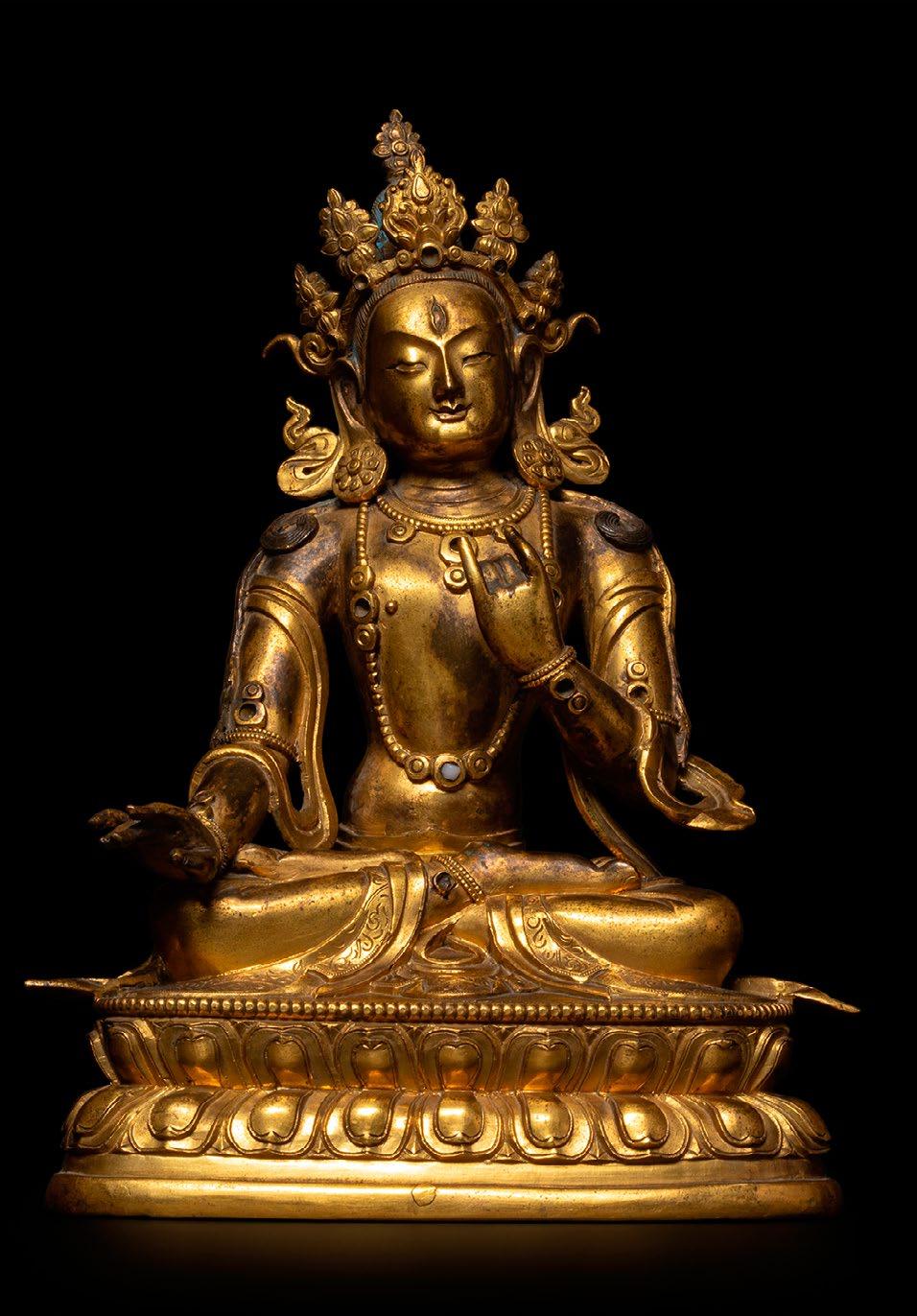
8 - ASIAN ART SOCIETY

june 2024 - 9
02
Budd H a P R ea CH ing
H i S Fi RS t Se R m O n
Tibet
12-13th century
Mineral pigment on cloth
31,5 cm x 24 cm
Back inscription
“Om Ah Hum”
“Zab (cave) Zaandam (sandalwood) temple”
Provenance:
Asian private collection
Price on request
Obj EC t Pr ESE nt E d by:
Hollywood Galleries
T.: +852 2559 8688
+852 2541 6338
E.: hollywoodgalleries@gmail.com
W: www.hollywood-galleries.com
A majestic Buddha seated on a lion and lotus throne, adorned with a round halo, which is embellished with two blue lion-headed vyala and mythical sea creature Makaras, on either side. Above the halo, a bodhi tree and a royal umbrella symbolize enlightenment and sovereignty.

10 - ASIAN ART SOCIETY

In this thangka, the Buddha is depicted holding the Dharmacakra Mudra, also known as the Turning the Wheel Mudra. This hand gesture represents the Buddha’s act of teaching and transmitting the Dharma, symbolizing the continuous cycle of wisdom and knowledge shared with his disciples.
Flanking the Buddha are two half-kneeling bodhisattvas : Avalokiteshvara, the bodhisattva of compassion, and Maitreya, the future Buddha. They serve as divine companions, embodying compassion and the promise of future enlightenment.
The composition of the thangka is further enriched by the presence of monks and bodhisattvas in the corners, surrounding the central figure. These celestial beings and devoted practitioners represent the supportive community and the aspiration for spiritual growth and liberation. This style is commonly associated with the 11th to 12th century.
A similar painting can be found from the Pritzker collection, published by The Art Institute of Chicago, “Himalayas: An Aesthetic Adventure”, 2003, p.150-151, no. 99.
12 - ASIAN ART SOCIETY

june 2024 - 13
aBH aya K a R agu P ta
Tibet-China
18th century
Mineral pigment on cloth
100,3 cm x 59,7 cm
Provenance:
Private New York collection, acquired in the 1960s, by repute
Thence by descent
Price on request
Obj EC t Pr ESE nt E d by:
Kapoor Galleries
T.: + 1 (212) 794-2300
E.: info@kapoors.com
W: www.kapoors.com
The subject of this painting, Abhayakaragupta, can be described as a Panchen Lama preincarnation. The Vajrayana Buddhist teacher who lived in the eleventh century was a prolific scholar who served as the abbot of the great monastic college and monastery Vikramashila at its height, authored the earliest known system of biographies of the Eighty-four Mahasiddhas, and much more.
The Panchen Lamas are a political and religious incarnation lineage identified by the Fifth Dalai Lama, beginning with his closest tutor Lobsang Chokyi Gyaltsen (1570–1662). The Panchen Lamas recognized in their lifetimes acted as the abbots of Tashilhunpo Monastery of Shigatse in Tsang Province (Central Tibet). The later-devised Tashilhunpo lineage of incarnations (distinct from that of the central Gelukpa administration of Tibet known as the ‘Ganden Phodrang’) begins with figures who were posthumously recognized and refers to Kedrub Geleg Pal Zangpo (1385-1438) as the first Panchen Lama.
The present painting is the fourth of thirteen compositions depicting the Tashilhunpo lineage of Panchen Lama incarnations, designed at Narthang Monastery in Tsang Province and widely disseminated in the form of woodcuts by the mid-eighteenth century. Abhayakaragupta is depicted among Vajrayogini at top left, the siddha Ratnasambhava at top right, and Mahakala Panjaranatha at bottom right.
14 - ASIAN ART SOCIETY
03

While the present painting almost certainly began with the block print itself, the great detail seen in the finished product is attributable to the anonymous eighteenthcentury Chinese painter. The origin of this artwork is thus distinguished by his hand, as well as the mounting style and what appears to be an original textile, decorated with the traditional fu or winged bats which denote good fortune.
Himalayan Art Resources (himalayanart.org), item no. 7718.
16 - ASIAN ART SOCIETY

june 2024 - 17
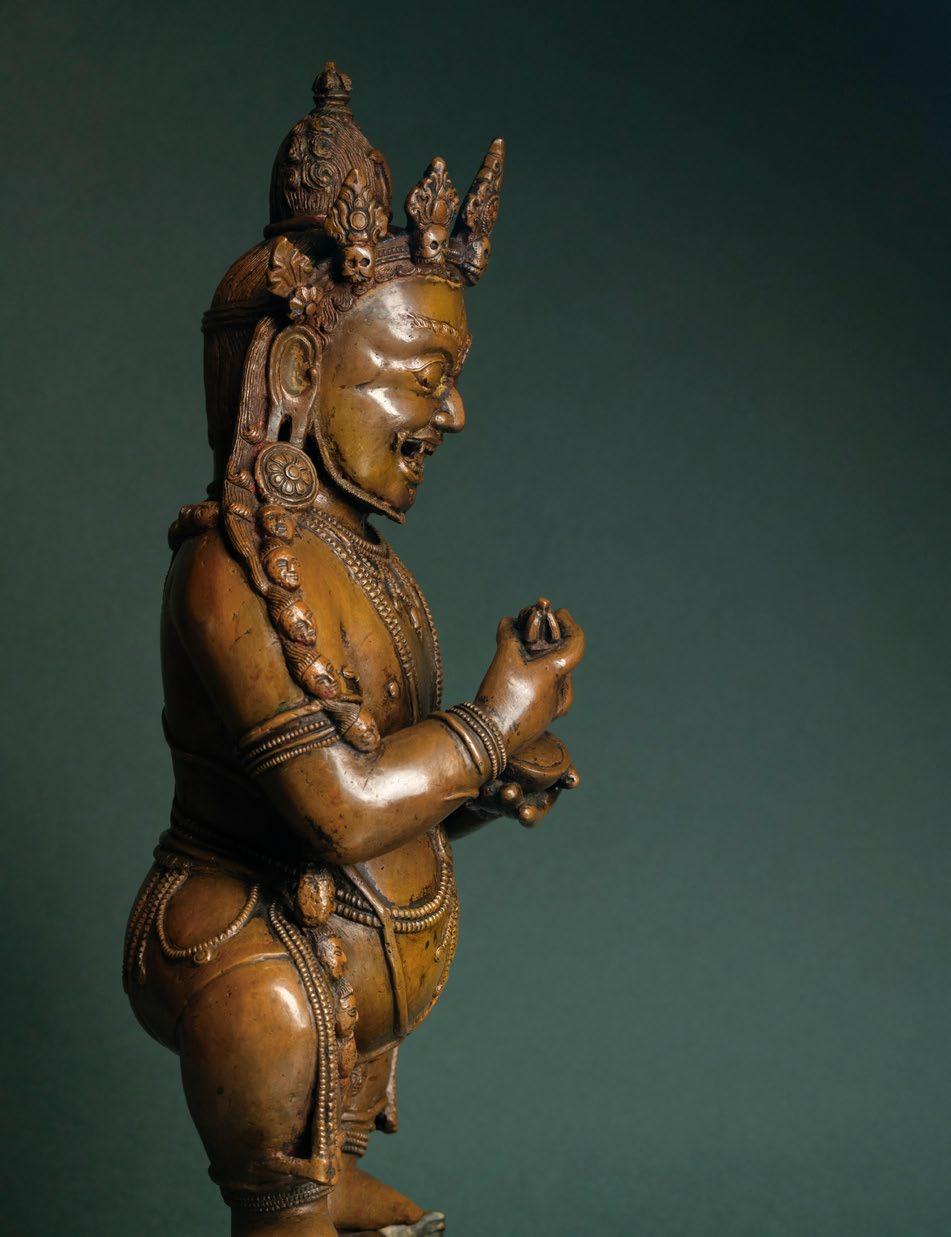
18 - ASIAN ART SOCIETY
tH e gR eat Bla CK One
m a H a K ala Pan Ja R nata
Western Tsang (gTsang), Southern Tibet
15th century
Copper alloy and brass
Height: 42 cm
Inscription:
‘You O Great Black One, who defeats all bgegs demons (demonic spirits who bring about ob- structions to human’s aims) – May you ensure and make firm the Buddha’s Teachings and the lives of the patrons who have heaven-sent wealth. May you bring together the realms of both the Buddhist teachings and that of secular governance. I also beg you to protect the lives of all sentient beings. May All Blessings Come Down on us!’
Provenance:
Thakuri family collection since 1940s
Price on request
Obj EC t Pr ESE nt E d by: Hollywood Galleries
T.: +852 2559 8688
+852 2541 6338
E.: hollywoodgalleries@gmail.com
W: www.hollywood-galleries.com
This powerful and rare image represents the complexity of the deity in a particularly convincing and aesthetically pleasing manner.
The wonderful casting which is completely without flaws, is perfectly smooth and its lustre is a fine example of the skills of the metal-casters in the region of southern Tibet at the time of its manufacture. It is possible that the image originally came from a Sakyapa monastery or family as this deity was particularly popular with those of the Sakya tradition in western Tsang at this time.
In his two-armed form Mahākāla is described in Tibetan iconographic works as being a dark grey colour and with a ‘third eye’ of wisdom. He holds a flaying knife in his right hand and a skull-cup in his left. The knife symbolically cuts off ignorance (skin) in order to reveal wisdom (flesh). The skull-cup contains blood which is the essential symbol of Wisdom itself.
He stands in perfect balance on top of a supine human body which represents all that was hostile to Buddhism and whose smile reflects the joyous state he exists in now after having subjected himself to the Great Black One.
june 2024 - 19 04

20 - ASIAN ART SOCIETY
Mahākāla is shown decked in ornaments which reinforce his outer aura of ferocity. He wears garlands of snakes as anklets, bracelets and has a cord round his torso which are said to represent the Eight Great Serpent-Kings whom he has defeated. His other ornaments are dried human skulls which represent the Five Great Apects of Wisdom which he has mastered. His crown with five skulls is another representation of the Five Wisdoms he has mastered.
It’s fortunate that this fine image has a well inscribed and clear inscription which gives us some important information about the reasons that the person who commissioned the present piece had for doing so.
- David Templeman, Monash University
june 2024 - 21

22 - ASIAN ART SOCIETY

june 2024 - 23
vaJR ad H a R a
Tibet
15th century Gilt-bronze
Height: 24,8 cm
Provenance:
Holger Rosell (1917–2009), Stockholm
The collection of the National Museum Prins Eugens Waldemarsudde, Stockholm
Uppsala Auktionskammare, 5 December 2014, lot 1001
Publication:
Himalayan Art Resources, item no. 8375.
Price on request
The present figure represents the primordial buddha Vajradhara. His hands crossed in front of his heart in vajrahumkara mudra (the gesture of the ‘adamantine sound’) holding a vajra/ dorje and ghanta/drilbu (bell)—make him easily recognizable. His elaborate ornaments identify him as a symbolic buddha in bodhisattva appearance.
This lustrous figure of Vajradhara is finely sculpted on a double-lotus base, clad in a dhoti with a shawl draped over his shoulders, flowing down symmetrically on either side of his torso to rest on his seat. An urna of inset turquoise sits below his five-leaf tiara behind which his hair is pulled into a neat pile surmounted by a half vajra. The complexity of the woven knots within his chignon is revealed from the backside of the sculpture, as is the careful execution of each element, despite the fact that these facets are frequently hidden.
The sculpture is embellished with small turquoise and ruby or garnet cabochons set in bezels to accentuate his crown, necklace, armbands, and belt—a style of inlay more common among Nepalese bronzes than Tibetan ones. However, the square face, the straight slope of the buddha’s nose in profile, the exclusion of a garuda element from the crown, and the festooned design of Vajradhara’s prominent necklace point to a Tibetan origin.
Obj EC t Pr ESE nt E d by:
Kapoor Galleries
T.: + 1 (212) 794-2300
E.: info@kapoors.com
W: www.kapoors.com
24 - ASIAN ART SOCIETY 05
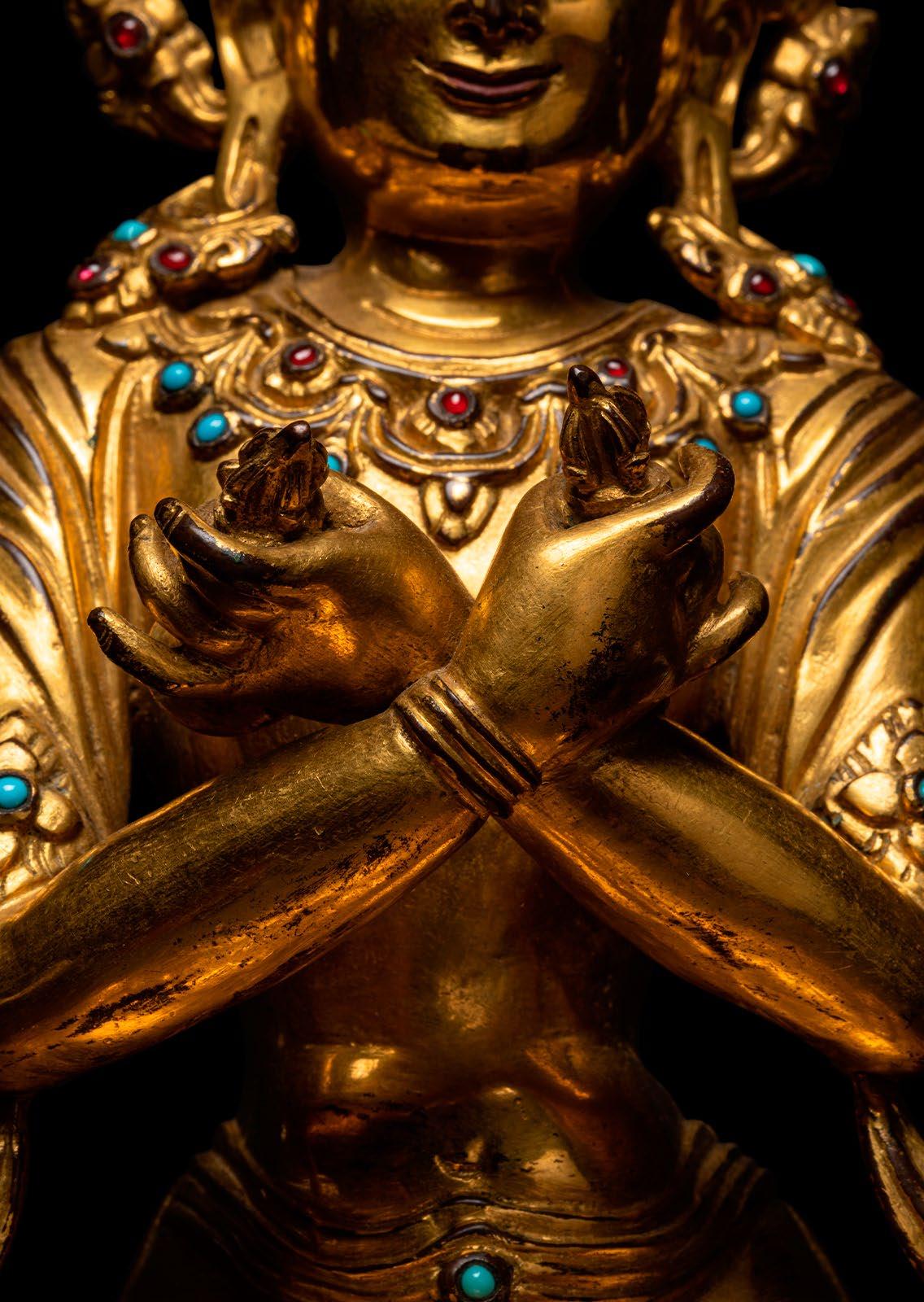

26 - ASIAN ART SOCIETY
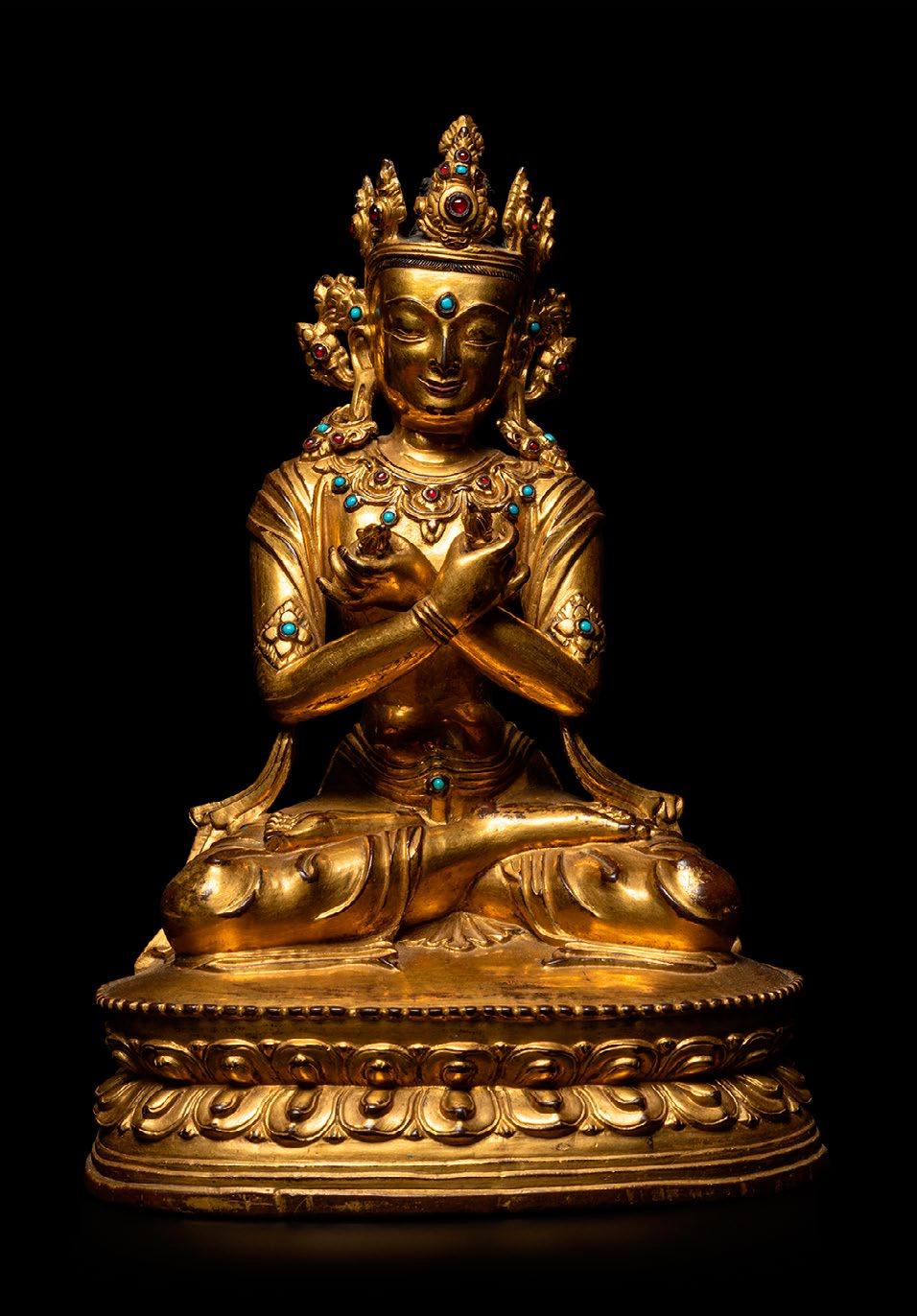
june 2024 - 27
m ait R eya
B O d H i S attva
Tsang Province, China
Circa 15th century
Brass with silver and copper inlay
Height: 15,2 cm
Provenance:
New York Gallery on January 28, 1972
Publication:
Himalayan Art Resources, item number 7573
Price on request
Obj EC t Pr ESE nt E d by:
Kapoor Galleries
T.: + 1 (212) 794-2300
E.: info@kapoors.com
W: www.kapoors.com
This exquisite and finely cast sculpture depicts Maitreya, the bodhisattva of loving kindness and the Buddha of the future. He is seated in dhyanasana (meditative posture) atop a double lotus base with his hand in Abhayamudra (gesture of fearlessness), gently clasping the stem of a lotus blossom which rises up around his shoulders, supporting a kundika (waterpot). He is adorned in fine jewelry and a thin dhoti (loincloth) with intricately incised borders billowing around his legs. His top knot is secured by a five-foliate crown and topped by a stupa. His slightly tilted head and sensitively modeled facial features give him a gentle welcoming demeanor. The present sculpture displays the superior quality and elegance of Tibetan sculptures.
28 - ASIAN ART SOCIETY 06


30 - ASIAN ART SOCIETY

june 2024 - 31
nOH ma SK OF Koomote
Japan Edo period 17th century
Wood
18 cm (h.) x 15 cm (w.) x 7 cm (D.)
Price: 22.000 euros
Obj EC t Pr ESE nt E d by:
Gregg Baker Asian Art
M: +32 (0) 469 498 489
E: info@japanesescreens.com
W: www.japanesescreens.com
Koomote (lit. ‘small face’) is one of the most common types of onnamen (women’s masks) used in Japanese traditional Noh theatre. The face with an engaging, gentle smile represents the innocent beauty of a young lady and is used for both main and supporting roles portraying young women and girls. Based on the beauty ideal of aristocratic ladies of the Heian period (794-1185), the mask is decorated in a white gofun (a gesso made from powdered oyster shells), the smiling red lips reveal teeth in black (ohaguro), the smudge-like eyebrows are painted, and the black hair is neatly combed and parted in the middle with the detail of three hairs along each side of the forehead.
32 - ASIAN ART SOCIETY 07


34 - ASIAN ART SOCIETY
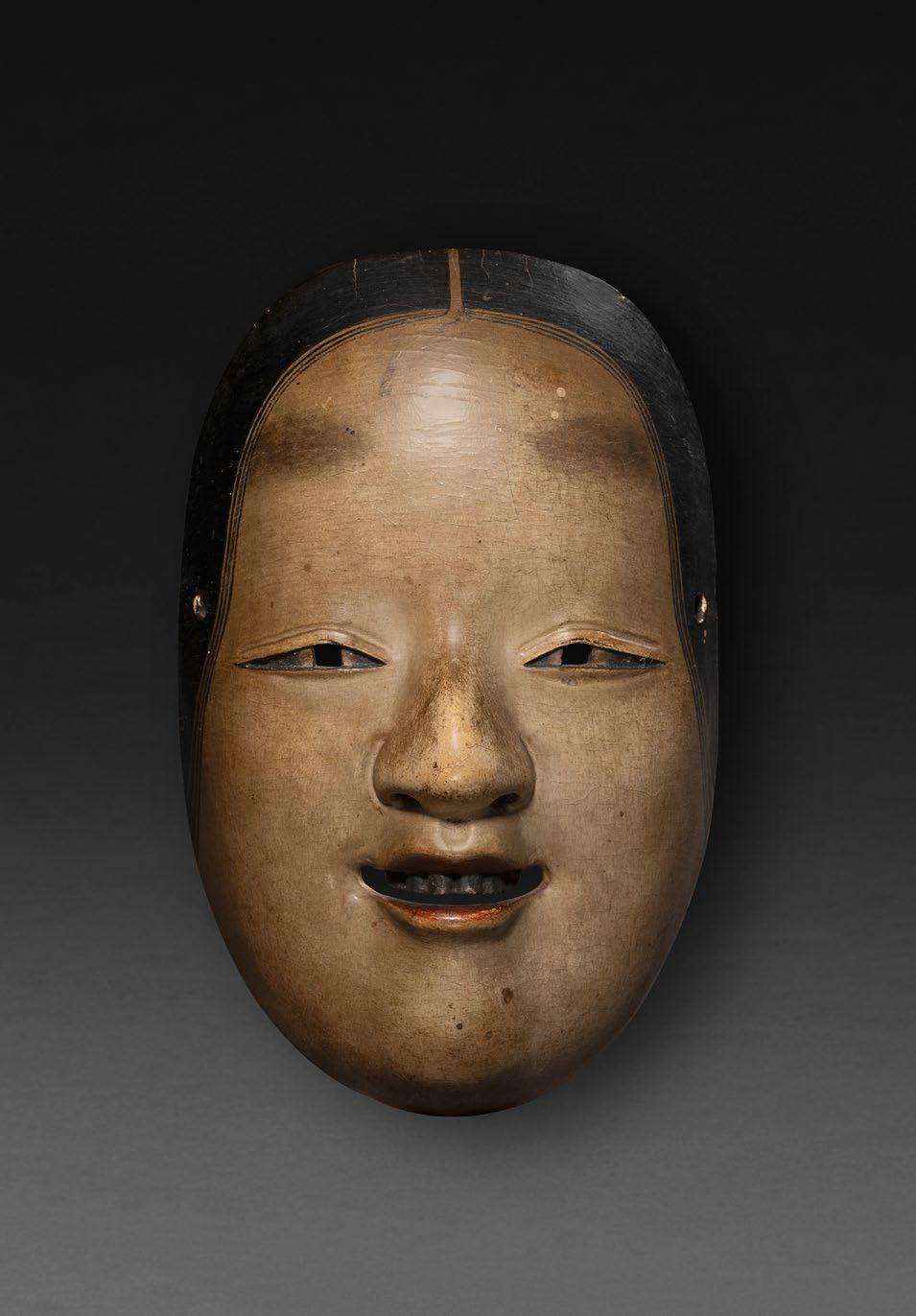
june 2024 - 35
A large lacquered wood mixing bowl, urushi bachi, of shallow circular form with wide flattened rim, the interior covered in a thin red lacquer
urushi bachi
Japan
Showa period (1926–1989)
Red lacquer
Diam.: 63,5 cm
Price on request
Obj EC t Pr ESE nt E d by: Rasti Fine Art Ltd.
M.:+852 2415 1888
e.: gallery@rastifineart.com
W: www.rastifineart.com
36 - ASIAN ART SOCIETY 08

june 2024 - 37
urushi bachi
Japan
Showa period (1926–1989)
Thick deep black and faint red lacquer
Diam.: 82 cm
Price on request
Obj EC t Pr ESE nt E d by:
Rasti Fine Art Ltd.
M.:+852 2415 1888
e.: gallery@rastifineart.com
W: www.rastifineart.com
A large lacquer mixing bowl, urushi bachi, of shallow circular form with wide flattened everted rim, the interior and exterior covered in thick deep black and faint red lacquer, the exterior covered in drips in the same tones.
38 - ASIAN ART SOCIETY 09

june 2024 - 39
a S i X-FO ld Pa P e R
SCR een
Japan
Edo period
17th century
120 cm (h) x 279 cm (w)
Price on request
Obj EC t Pr ESE nt E d by:
Gregg Baker Asian Art
M: +32 (0) 469 498 489
E: info@japanesescreens.com
W: www.japanesescreens.com
A six-fold paper screen painted in ink and colour on a gold ground with the scene of the Plains at Musashino where the silver moon is rising amongst hagi (bush clover), kikyō (bellflower), nogiku (asteroideae), nadeshiko (fringed pinks) and other autumnal grasses
In the realm of meisho-e (pictures of famous scenic places), the portrayal of a large full moon or sun viewed through autumnal grasses represents Musashino (the Musashi plain).
The plain of Musashi was a large flat expanse of land west of Edo, most famous for the illusion of the moon rising straight out of the grasses and similarly the sun appeared at its largest size and deepest shade of red just before setting into the horizon.
A poem celebrating this famous landscape was written by the aristocrat Minamoto Michikata (1189–1238) and is included as no.425 in the imperial poetry anthology of c.1265, the Shokukokin Wakashu (Collection of Ancient and Modern Poems Continued).
Musashino wa tsuki no irubeki mine mo nashi obana ga sue ni kakaru shirakumo
On the Musashi plain there is no peak for the moon to enter white clouds catch in the tips of the flowers.
40 - ASIAN ART SOCIETY 10

This famous location also appears in Chapter 12 of the 10th century novel Ise Monogatari (Tales of Ise) where a young couple elope and hide amongst the tall grasses of Musashino. When their pursuers threaten to set fire on the grasses the lady pleads for mercy with the waka poem that reads:
Musashino wa kyō wa na yaki so Wakakusa no
tsuma mo komoeri ware mo komoeri
Oh no, please, today do not burn the Musashi Plain! Tender as young grass, my beloved is hiding here, and I too am hiding here.
During the Edo period Musashino was frequented by picnickers inspired by its haunting beauty, poetic references and spectacular views of Mount Fuji. After the recent era of industrialisation Musashi lost
its original landscape and is currently an area located in the centre of the metropolis of Tokyo.
For other examples of this subject matter in the collection of the Chicago Art Museum see: Japanese Design in Art vol.12 p.32-33, pl.25 and another pair in the collection of the Nezu Museum see: Catalogue of Selective Masterpieces from the Nezu Collections, Painting and Calligraphy, p. 162-163, pl. 138. Also for a further pair of six-fold screens in the collection of Fujita Museum see: Nihon Byōbue Shūsei, vol.9: Shiki Keibutsu (Natural Features of Four Seasons), p. 84-87, no.70-75, 77-78, 80.
n.b. There are numerous areas where old repairs have been made to small cracks and rents throughout the screen which are commensurate with age. Please see the fully marked illustration of these areas in the attached document.
42 - ASIAN ART SOCIETY


44 - ASIAN ART SOCIETY

june 2024 - 45
Budd H a Head
Thailand
Kingdom of Chiang Sen (14th-15th century)
15th century
Bronze
Height: 29 cm
Provenance:
Private collection, Germany
Price on request
Obj EC t Pr ESE nt E d by: Christophe Hioco
T: +33 (0) 1 53 30 09 65 E: info@galeriehioco.com W: www.galeriehioco.com
In northern Thailand, the city of Chiang Sen, founded in 1327, was the capital of the small vassal Lanna Kingdom with which it shared a varied history. The city was an active centre for bronze-casters who had their own characteristic style. It is thought that Sukhothai casters came north and helped create this particular aesthetic style. That is why it has certain traits of the Sukhothai style, such as the hooked nose, dimpled cheeks, eyebrows arching to the bridge of the nose, and hair with tiny juxtaposed curls. But when all this is put together, the effect is different, less decorative, closer to the spirit of classic Indian Buddhist statues, more vigorous, imposing and majestic.
While the face is more radiant than Sukhothai art dictates, it is more refined than that of many creations from the north, such as Phra Singh-type Buddhas.
46 - ASIAN ART SOCIETY 11
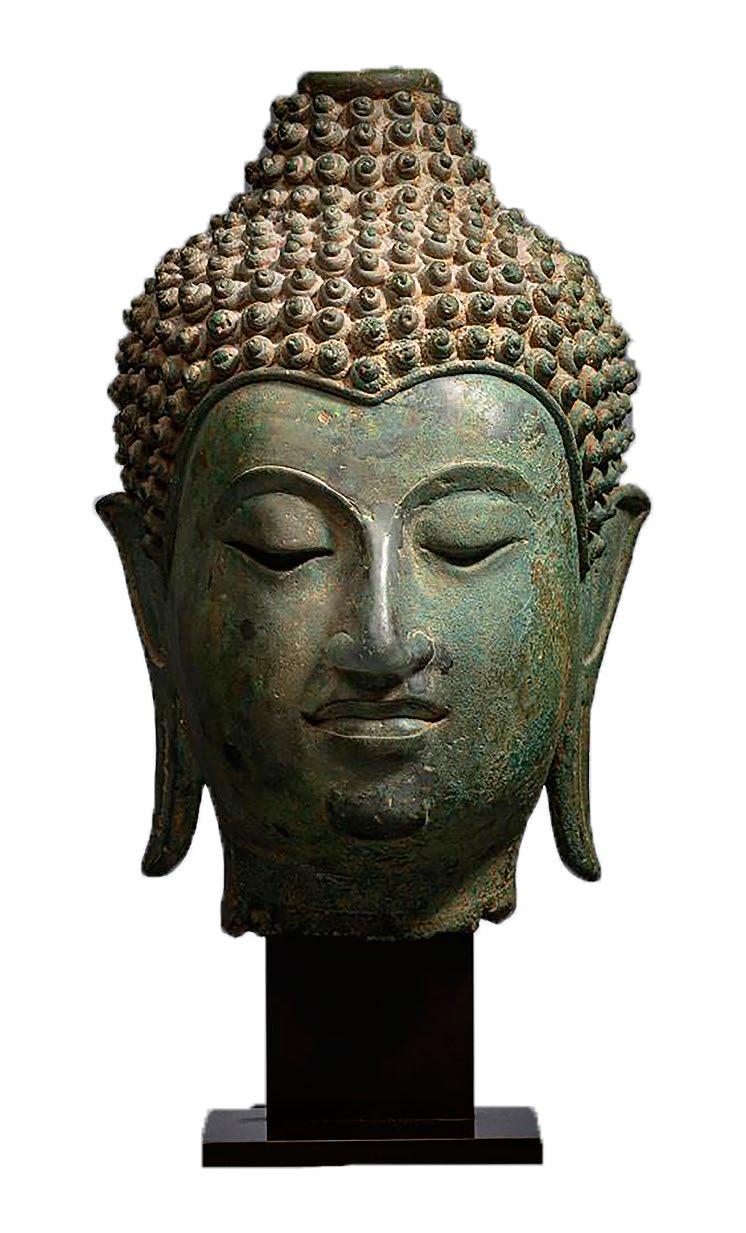
june 2024 - 47
Seated B udd H a
Thailand 15th century Bronze
Height: 27 cm
Provenance:
Mr M. Laos
Etude Marie-Françoise Robert, 2004
Price on request
Obj EC t Pr ESE nt E d by: Christophe Hioco
T: +33 (0) 1 53 30 09 65 E: info@galeriehioco.com W: www.galeriehioco.com
Śākyamuni is depicted here seated on a lotiform base in the so-called “noble” attitude (sattvaparyaṅka): the right leg is bent over the left leg, with only one sole of the foot remaining visible. He is sketching the gesture of taking the earth as witness, one of the six canonical gestures (mudrā) made by the Buddha at the main events of his life.
His features are characteristic: his pensive face is decorated with arched eyebrows that meet above his aquiline nose. His mouth reveals a discreet yet serene smile. At the top of the skull, above the highly developed protuberance (or u ī a), stands a flame (rasmi), a symbol of the Blessed One’s spiritual strength. Fortunately preserved, this ornament is an influence of Sri Lankan art.
The well-preserved bronze patina here retains traces of gilding on the face. The face perpetuates the Sukhothai aesthetic, with the superciliary arches extending over the bridge of the nose, the hair treated in small juxtaposed curls and the beauty folds on the neck.
48 - ASIAN ART SOCIETY
12

50 - ASIAN ART SOCIETY

june 2024 - 51
a g O ld ne CK CH ain and P endant OF H indu deity
Tanimbar/Maluku, Indonesia
17/18th century
2,5 cm x 6,5 cm (pendant)
Weight: 54,5 gr
Provenance: Abdulgani collection Indonesia
Price on request
Obj EC t Pr ESE nt E d by: Sue Ollemans
M.: + 44 (0) 7775 566 356 E.: sue@ollemans.com W: www.ollemans.com
As said, it comes from the rarified Abdulgani collection, source of the absolute top tribal gold from Indonesia. While the piece originates in Tanimbar/Maluku, the pendant clearly is either influenced by later Majapahit design or even originated in Java though the reddish patina on both the chain and the pendant are clearly in line with ancient Maluku patinas. The spice trade in the Maluku islands preceded the arrival of the Portuguese, Dutch and English traders by centuries and already during the late Majapahit times there were close connections between Java and the faraway islands of the Moluccas. Hence it stands to reason that Hindu/Buddhist icons would have been exchanged as prestige items, possibly confirming a vassal relationship between the mighty Java empires and the outer spice islands.
52 - ASIAN ART SOCIETY 13

54 - ASIAN ART SOCIETY
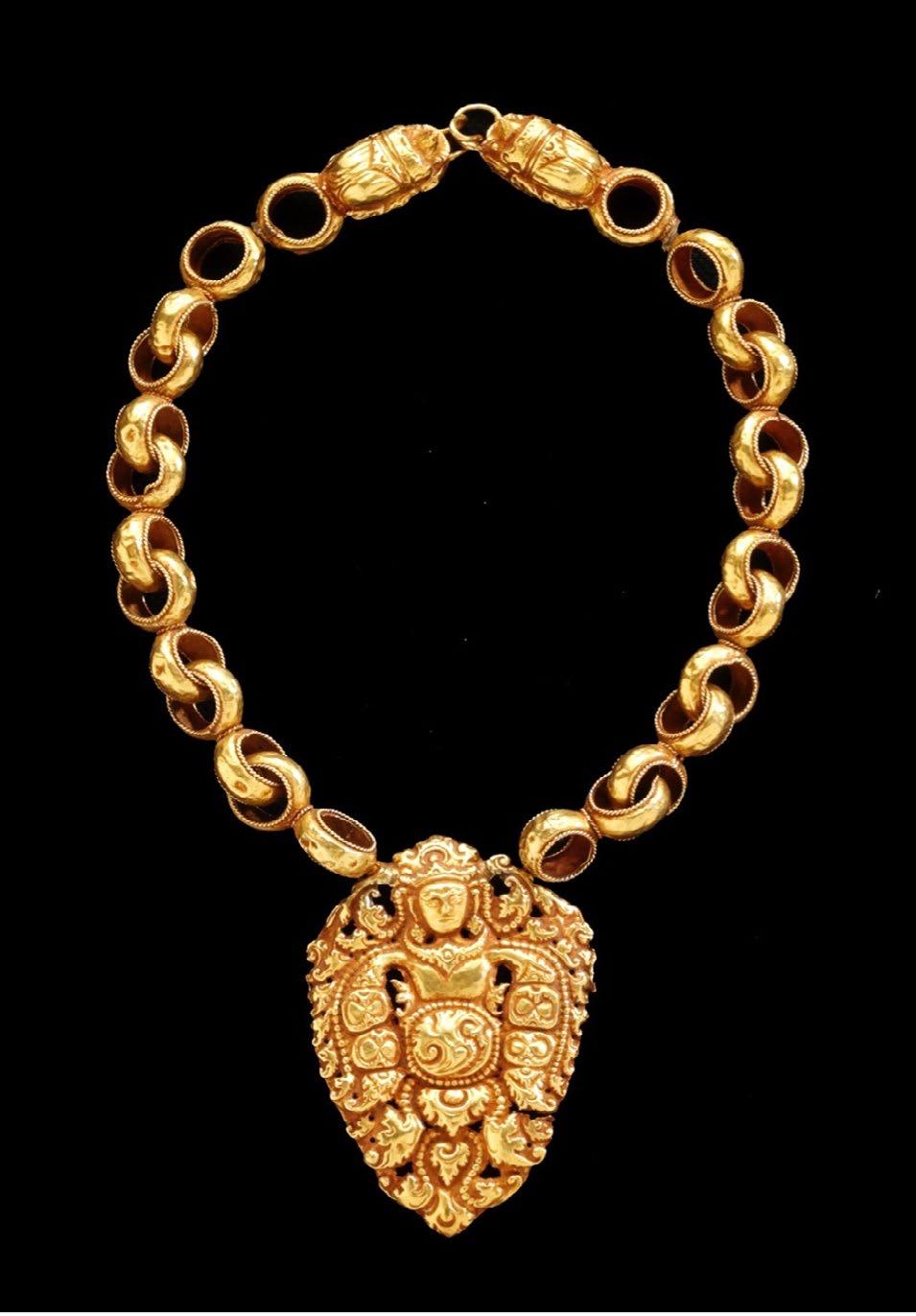
june 2024 - 55
s ora langi
WO man’S tu B e SK i R t
Galumpang Toraja, Sulawesi, Indonesia
Second half of 19th century
Cotton; warp ikat
183 cm x 145 cm
Price on Request
Obj EC t Pr ESE nt E d by:
Thomas Murray
M.: + 1 415.378.0716
E.: thomas@tmurrayarts.com
W. : www.tmurrayarts.com
Sora langi is the name of a rectangular cloth that could be stitched up on the vertical seam and worn as a tube skirt, however many were kept as flat textiles and used ceremonially. These are relatively rare and comparatively early, with this most likely dating to the mid 19th Century. It is thought that they were woven in Galumpang to the taste of the ethnic groups living to the north in the Bada, Napu and other valleys. The colors are deep and the fine line progressions offer a very fine aesthetic.
56 - ASIAN ART SOCIETY 14
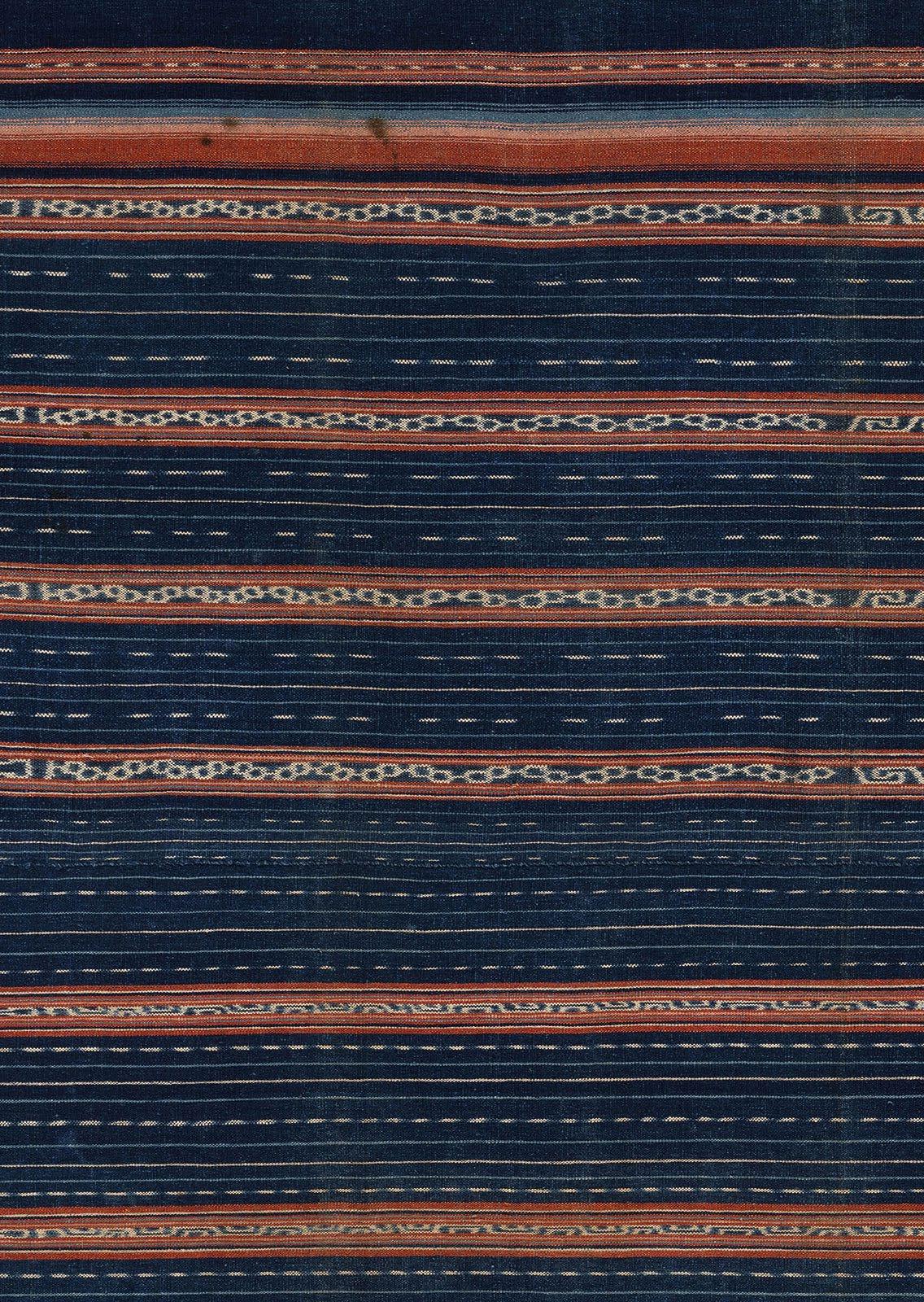
58 - ASIAN ART SOCIETY

june 2024 - 59
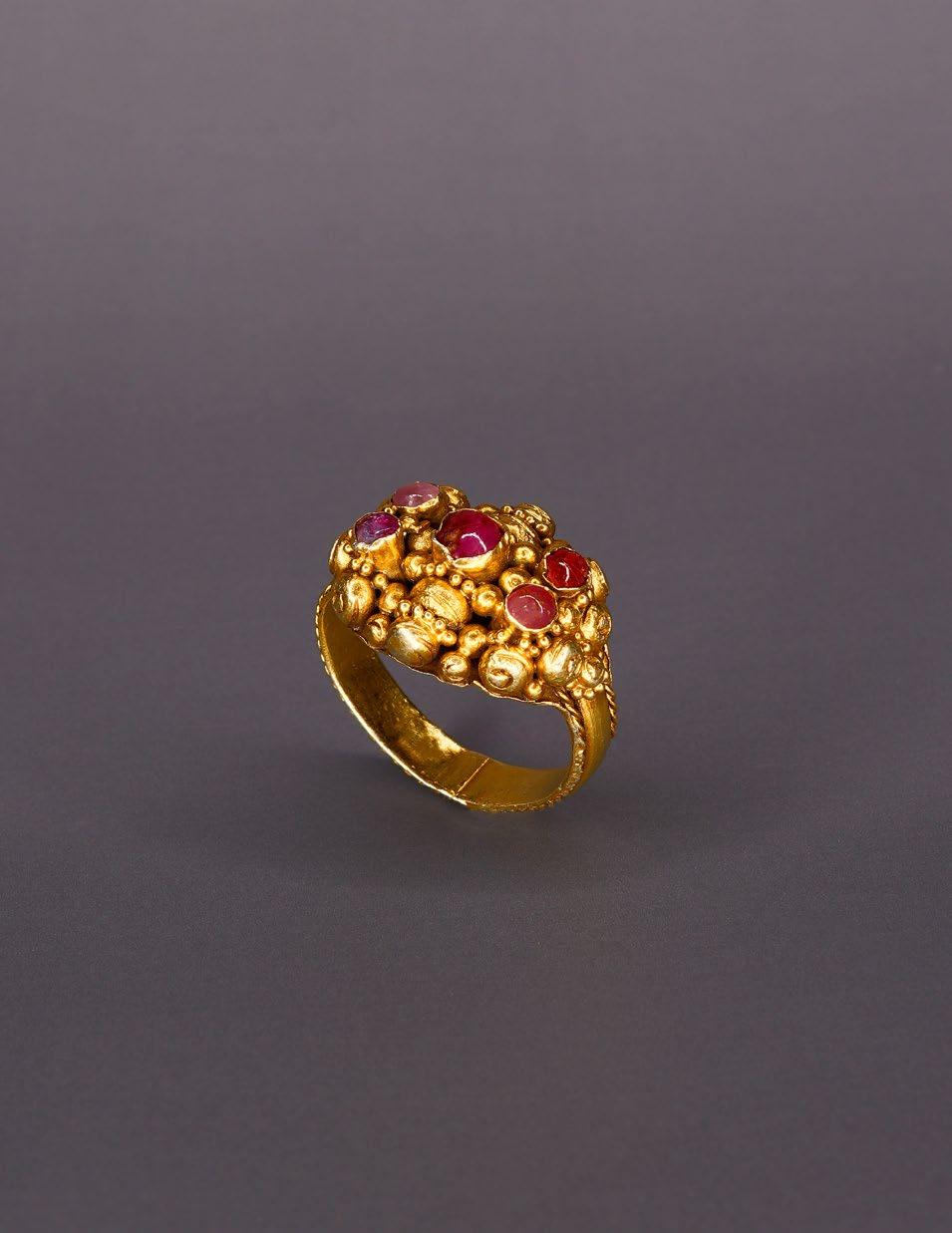
60 - ASIAN ART SOCIETY
a Ru B y and diam O nd
R ing S et W it H g O ld g R anulati O n
Bali, Indonesia
19th century Size: 8,5 US
Price on request
Obj EC t Pr ESE nt E d by: Sue Ollemans
M.: + 44 (0) 7775 566 356 E.: sue@ollemans.com W: www.ollemans.com
june 2024 - 61 15
S H aman’S S WOR d W it H dee R antle R H andle and a RCH ai C S teel B lade
Sword Sulawesi, Indonesia Steel, antler
76,8 cm x 13,3 cm x 5 cm
Price: 1.800 and 1.500 USD
Obj EC t Pr ESE nt E d by:
Thomas Murray
M.: + 1 415.378.0716
E.: thomas@tmurrayarts.com
W. : www.tmurrayarts.com
62 - ASIAN ART SOCIETY 16


64 - ASIAN ART SOCIETY

d aya K S t R i PS
Strips with Curvilinear Decorations
Iban Dayak Borneo
19th century Brass
22,8 cm x 2,85 cm x 0,16 cm
Price: 900 USD
Obj EC t Pr ESE nt E d by:
Thomas Murray
M.: + 1 415.378.0716
E.: thomas@tmurrayarts.com
W. : www.tmurrayarts.com
Rare surviving elements from an Iban woman’s metal belt.
66 - ASIAN ART SOCIETY 17

68 - ASIAN ART SOCIETY
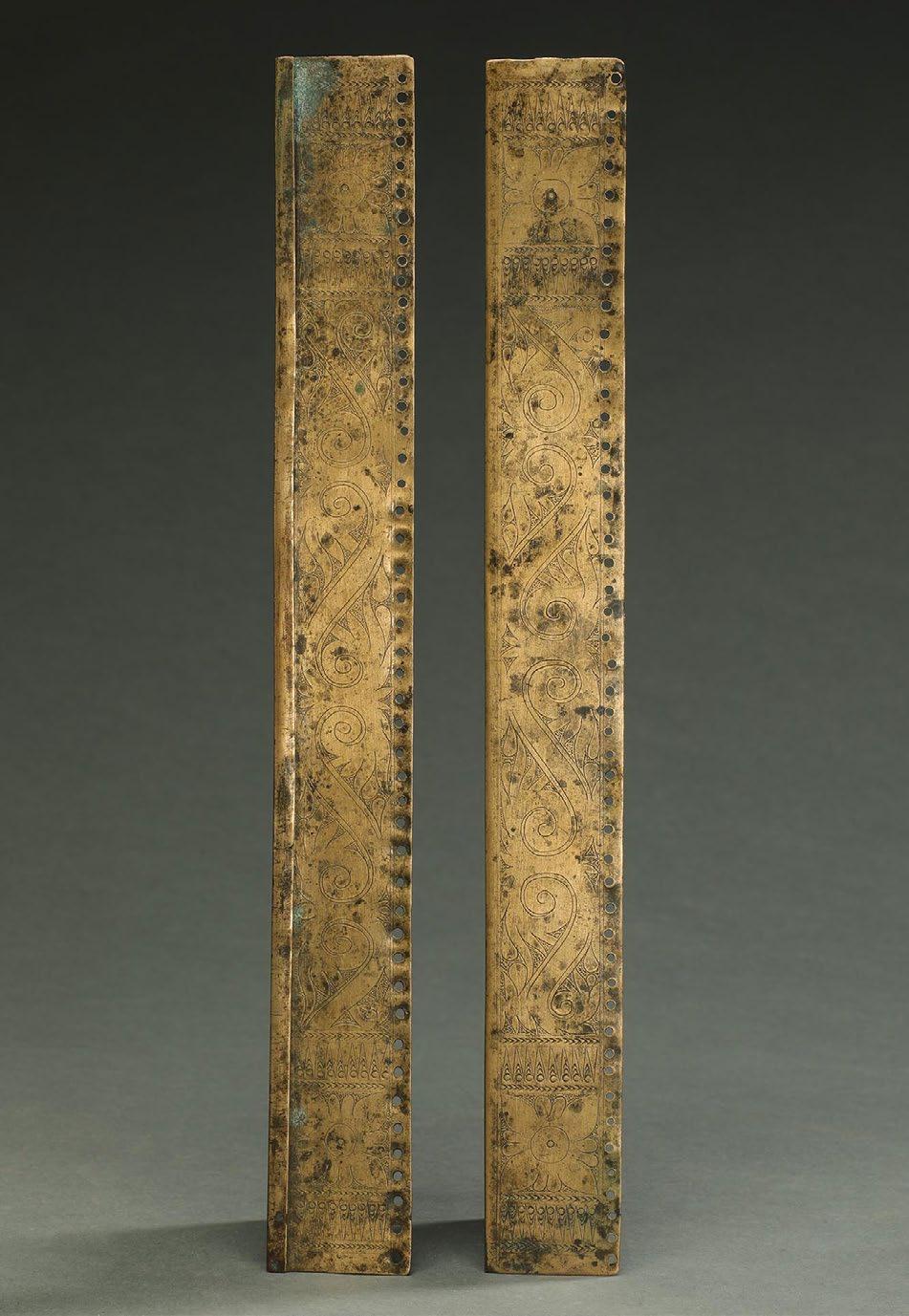
june 2024 - 69
vai ROC ana
Kashmir Gilgit, India
8-9th century
Copper alloy with silver inlay
Height: 31,5 cm
Provenance:
Benny Rustenburg Dutch collection (1940-2017)
Price on request
Obj EC t Pr ESE nt E d by:
Hollywood Galleries
T.: +852 2559 8688 +852 2541 6338
E.: hollywoodgalleries@gmail.com
W: www.hollywood-galleries.com
Vairocana, is a central figure in Mahayana Buddhism and is revered as one of the Five Dhyani Buddhas, also known as the Five Wisdom Buddhas. Vairocana is considered the embodiment of the Dharmakaya, the ultimate nature of reality and the primordial essence of enlightenment.
This bronze statue depicts Vairocana holding bodhyagri mudra, with his right hand holding left hand’s index and middle fingers. He is seated on a magnificent five-lion lotus royal throne, symbolizing his regal and enlightened presence. The lion, associated with strength and noble qualities, adds an element of majesty to the composition.
An intriguing feature of this statue is the silver inlaid eyes and the third eye, and the unusual style of the halo framing radiant aura. Resembling a bodhi tree or reflecting the Greco-Buddhist influence of the Gandhara region, it adds a unique touch to the piece. At the top of the halo, there is a small stupa, a Buddhist symbolic structure that represents the enlightened mind and the path to liberation.
The contemplation of a Vairocana statue is believed to bring about a deep understanding of the interdependence of all phenomena and the ultimate realization of the nature of reality. It is a visual representation and a focal point for contemplating the profound teachings and qualities associated with Vairocana, inviting practitioners to awaken their own inner wisdom and compassion.
70 - ASIAN ART SOCIETY 18

72 - ASIAN ART SOCIETY
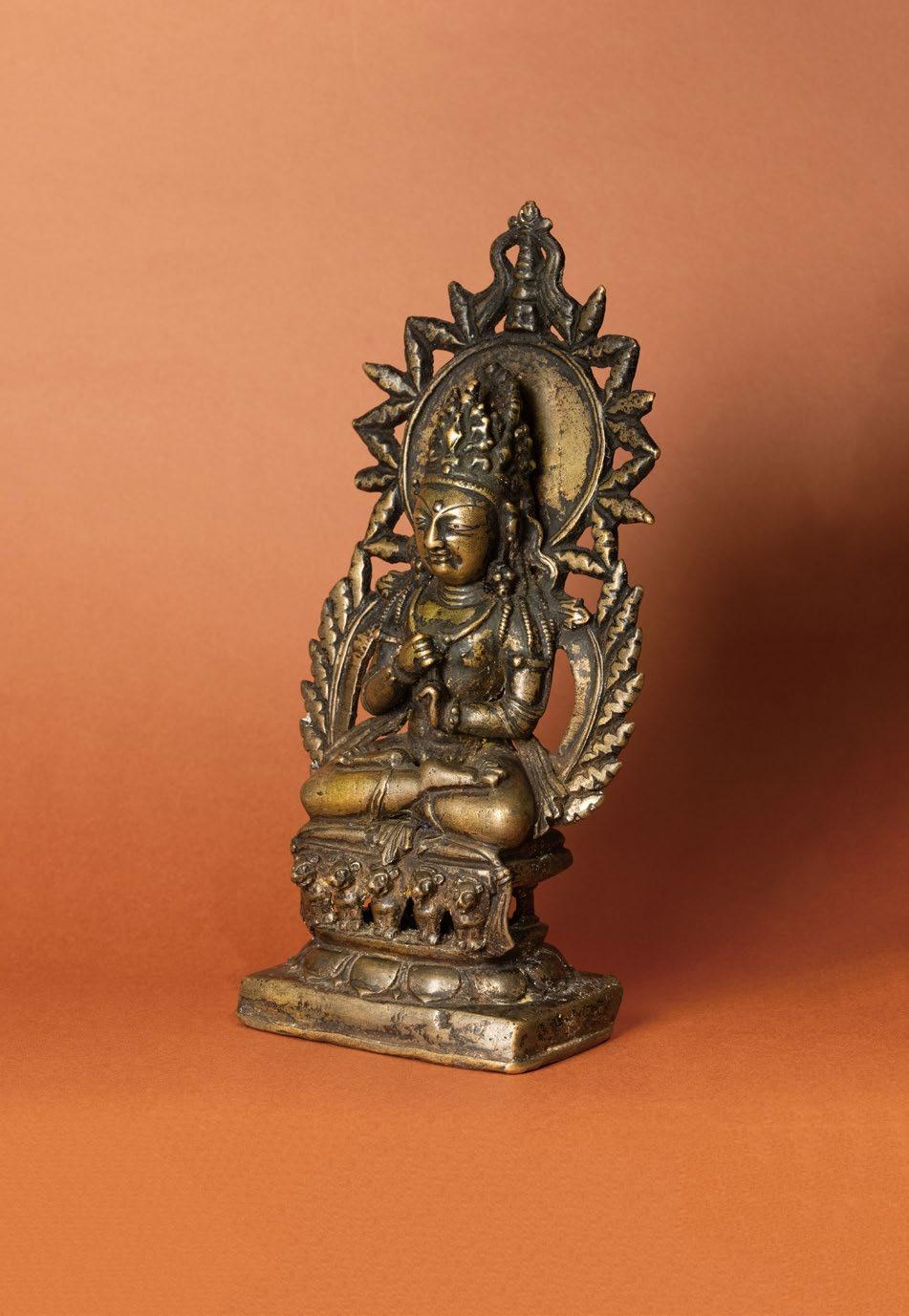
june 2024 - 73

Stele of Umā m aheśvara
Eastern India
Pāla period
9th-10th century
Black stone
Height: 86 cm
Provenance:
Sotheby’s, 2005
Private collection
Price on request
Obj EC t Pr ESE nt E d by:
Christophe Hioco
T: +33 (0) 1 53 30 09 65
E: info@galeriehioco.com
W: www.galeriehioco.com
This superb stele depicts the Hindu god Śiva in his umāmahēśvaramūrti aspect. This iconography is described in two texts: the Vi udharmōttara and the Rūpama ana (Rao, 1971, vol. II, Part. I, p. 132). It depicts Śiva and his wife, called in this context umā, the ‘Favorite’, sitting on the same seat, showing each other signs of attachment and often surrounded by their children and relatives. This subject can be subject to variations in the positions of the protagonists and the number of characters. Several large bas-reliefs in the ellorā caves (8th century) bear witness to this. In southern India, the theme bears the name of Sōmāskandamūrti and was the subject of numerous processional bronzes. In nepal, present from the fifth century, umāmaheśvara became over the centuries the śaiva iconography par excellence.
Śiva is in a relaxed position, delicately embracing his consort. The two gods seem to be looking at each other; the delicacy of the modelling hints at their tender expression. umā holds in her hand a mirror symbolising her beauty, while her husband holds in one of his hands his main attribute, the trident (triśūla). Their bodies are richly adorned with various ornaments. The two deities are not alone: at their feet, under the lotiform seat, stand two familiars: the nandin buffalo and the lion, the respective mounts (vāhana) of the two deities. Above their heads float two flying celestial creatures (vidyādhara), against a background of an ornamental floral frieze. At the very bottom of the sculpture is an orant, a figure in a position of prayer: this is probably the patron of the work.
However, despite these various details, the
june 2024 - 75 20
work is characterised by its sobriety, as well as by its remarkable size. The postures are elegant without being excessive, the ornaments delicate, revealing an underlying sensuality. It is a remarkably well-preserved work, with clear iconography and no superfluous elements. The dark stone also gives the scene a certain intimacy.
76 - ASIAN ART SOCIETY

june 2024 - 77
Kilim B lan K et
Central Anatolia, Turkey
20th century
Cotton, wool; eccentric wefts
302 cm x 163 cm
Price on request
Obj EC t Pr ESE nt E d by:
Thomas Murray
M.: + 1 415.378.0716
E.: thomas@tmurrayarts.com
W. : www.tmurrayarts.com
78 - ASIAN ART SOCIETY 19


80 - ASIAN ART SOCIETY

june 2024 - 81
